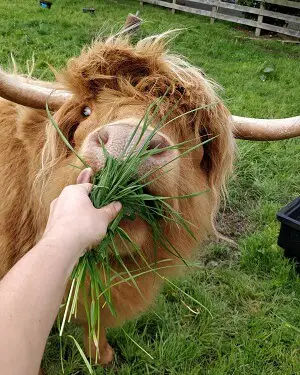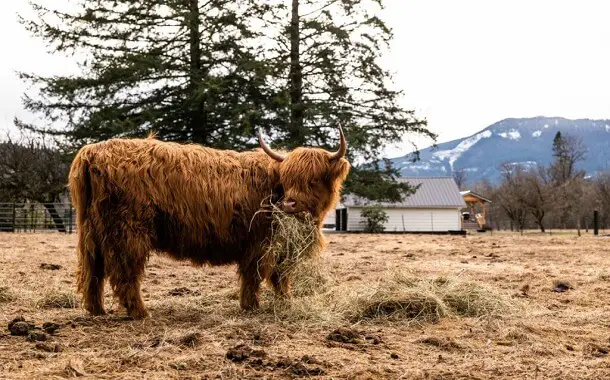How Much Does It Cost to Feed a Highland Cow?
Last Updated on February 6, 2024
Written by CPA Alec Pow | Content Reviewed by ![]() CFA Alexander Popinker
CFA Alexander Popinker
Understanding the costs associated with feeding Highland cattle is an important part of budgeting and planning when raising these unique cows.
While expenses can vary based on your location and management practices, this guide will provide an in-depth look at the typical costs and detailed nutrition requirements to consider when estimating your Highland cow feed budget.
How Much Does It Cost to Feed a Highland Cow?
The total annual cost to feed a Highland cow typically ranges from $400 to $800 on average. However, this can vary significantly depending on several factors:
- Geographic location – Hay and feed prices can fluctuate dramatically based on regional costs and availability. Areas with higher demand and more limited farmland tend to have higher market rates for all feeds.
- Sources of feed – Feeding your own farm-grown hay and utilizing your own pastures reduces costs compared to purchasing all feed. However, adequate land, soil fertility, equipment, and time are required.
- Level of supplemental feeds – Providing added vitamins, minerals, concentrates, and processed feeds increases overall feed costs but may provide nutritional benefits.
- Seasonality of feeding – Supplementing the diet with more hay and silage during the winter is more expensive than grazing through the growing season. Cold climates have higher annual costs.
- Cow’s age and size – Younger and smaller Highland cows naturally eat less than mature cows. The difference can be 20-30% less daily intake for calves and heifers.
With proper pasture management and supplementation, most small herds of 5-10 cows can be fed for around $500 to $600 per cow annually, assuming some purchased hay.
Larger herds above 20-30 cows or operations feeding premium commercial feeds may have annual costs of $700 to $800 per mature cow.
Here is a sample breakdown of the estimated annual feed costs for a 1,000 lb. Highland cow consuming a diet of pasture, hay, and supplements:
- Grass pasture – 5 months at $20/month = $100
- Hay – 10 bales per month for 7 months at $65/bale = $4,550
- Grain – 500 lbs. at $15/cwt = $75
- Mineral mix – 2 bags annually at $55/bag = $110
- Vitamins – 1 dose annually at $25/dose = $25
Total Estimated Annual Feed Costs: $860
This provides an example of real-world feed costs for a typical Highland cow. Actual expenses will depend on individual farm factors.
Scotland Kilt Collection notes that the cost of maintaining a Highland cow can vary depending on the location and size of the herd. You can expect to pay between $500 and $800 per Highland cow each year.
According to the A-Z Animals website, the annual costs of caring for a cow can range from $500 to $1,000 USD, not including the initial setup costs. The cost of feed can vary depending on how many cows you have and what they need. Pasture-based feeding is the least expensive, though the initial cost of land can be pricey. Per cow, expect the cost to range from $400 to $800.
As reported by Justagric, the average cost of feeding a Highland cow per month is approximately $75. This cost is based on an average of $2.5 per day to feed a Highland cow, resulting in a monthly cost of $75.
Detailed Dietary Needs of Highland Cows
To keep your Highland cattle healthy while controlling costs, it’s important to understand their nutritional requirements in depth:
Energy Requirements
Highlands require adequate calories and energy from their diet. This is provided by:
- Forages – Pasture grasses, hay, silage
- Grains – Barley, oats, corn
- Fats – Vegetable oils, animal fats
Energy needs range from 18-20 Mcal per day for an adult cow, depending on age and stage of production. Top-quality pasture provides adequate energy, reducing the need for grains.
Protein Needs
Dietary protein provides essential amino acids for growth and production. Important sources are:
- Legume hays – Alfalfa, clover
- Forage with legumes – Mixed grass-legume pastures
- Oilseed meals – Soybean, cottonseed, canola
Provide 12-18% crude protein in the total diet. Higher protein is crucial for lactating cows.
Vitamins and Minerals
Adequate vitamins and minerals in the diet are essential for many bodily processes. Key vitamins and minerals include:
- Vitamin A
- Vitamins D & E
- Calcium
- Phosphorus
- Magnesium
- Selenium
- Copper
- Zinc
These are often added through salt-mineral mixes designed for cattle. Deficiencies depend on soil fertility and forage quality.
Roughages – Fiber and Bulk
 The bulk of intake should come from roughages like grass, hay, and silage. Benefits include:
The bulk of intake should come from roughages like grass, hay, and silage. Benefits include:
- Provide bulk and rumen fill
- Promote chewing and rumination
- Supply fermentable fiber for rumen health
Highlands need at least 1.5-2% of body weight from roughage daily. Higher-quality forage reduces quantity needed.
Fluctuating Nutrition Requirements
Highland cattle are adapted to varied grazing conditions and have lower nutritional needs than other beef breeds. However, their requirements fluctuate based on:
- Spring/Summer – High-quality grazing can provide all key nutrients if rotated adequately.
- Fall/Winter – More hay and silage. May need dietary supplements.
- Lactating – Significantly higher protein, energy, and mineral needs.
Cost-Effective Feeding Strategies
The key to meeting Highland nutritional requirements affordably includes:
- Maximizing grazing during peak pasture growth to reduce hay usage.
- Soil testing pastures and only applying fertilizer if nutrients are deficient.
- Using intensive rotational grazing to improve pasture utilization and quality.
- Taking multiple cuttings of hay annually from high-yielding fields.
- Testing all harvested forages to detect any nutritional shortfalls early.
- Only providing minimal grain supplements for added energy during lactation or winter stress.
- Working with a qualified bovine nutritionist to develop cost-effective, balanced rations.
- Grouping cows by age and production stage and feeding accordingly.
- Purchasing bulk quantities of feeds when storage space allows. The more you buy at once, the lower the price per unit.
- Utilizing commodity feeds like corn gluten pellets to provide protein and energy affordably.
Components of Feeding Costs
There are several main expenses that make up the overall cost of feeding a Highland cow. These include:
Hay, Silage, and Pasture
Forage in the form of hay, silage, and pasture provides the foundation of the diet and the majority of a Highland’s nutrients. However, costs for these roughages can vary dramatically based on type, quality, location, and season.
Hay Prices and Expenses
- Hay prices depend heavily on cuttings, quality, type of hay, and geographic region.
- First cut hay costs less – around $3 to $5 per bale. Later cuttings increase in price.
- Higher protein legume hay costs more. Grass hay ranges from $4 to $9 per bale. Legume hay like alfalfa can be $10 to $15 per bale.
- Buying large round bales in bulk lowers per-unit price but requires storage.
- Large 900-1200 lb. round bales cost around $40 to $70 each for average grass hay.
- Hay prices also rise in colder climates where the growing season is shorter.
Silage Pricing and Production Costs
You might also like our articles about the cost of Miniature Highland Cows, feeding a horse, or hay bales.
- When grown and stored on the farm, silage costs much less than hay. But it requires more management and equipment.
- Producing around 20 tons of corn silage per acre with a double-cropping strategy can cost $600 to $800 per acre in expenses like seed, fertilizer, equipment use, and labor. This equates to $30 to $40 per ton.
- Purchasing from other farmers typically runs $40 to $60 per ton. Again, buying bulk lowers costs.
Pasture Expenses
- Grazing well-managed pastures is the least expensive way to feed Highland cows. But it requires land resources and diligent management.
- Costs may include:
- Soil testing – $20 per sample
- Fertilizing – $100 to $200 per acre
- Seeding – $100 to $200 per acre
- Weed control – $30 to $60 per acre
- Rotational grazing infrastructure – Fencing, gates, water systems
- Renting additional grazing land can cost $10 to $50 per acre monthly. This can stretch limited land further.
Supplements and Minerals
While forage should make up the majority of intake, supplements are often fed to provide additional protein, energy, vitamins, and minerals:
- Grains like oats, barley, or corn provide extra energy and protein. They cost around $300 per ton but are fed in small quantities, only 1-3 lbs. per cow daily.
- Protein supplements like soybean meal or distillers grains range from $400 to $500 per ton but are also fed sparingly, just 0.5-2 lbs. per cow daily.
- Vitamin and mineral supplements provide important micronutrients lacking in forages. These average around $50 per bag, with cows consuming around 0.5 lbs. per head daily.
- Individual vitamin injections or boluses cost around $20 per dose and are given once or twice annually.
Grazing and Land Management
If using your own pastures, expenses may include:
- Fertilizing/overseeding – $100 to $200 per acre
- Rotational grazing infrastructure – Fencing, water systems
- Rent for additional grazing land – $10 to $50 per acre monthly
Cost-Effective Feeding Strategies
Ways to balance Highland nutrition while controlling costs:
- Maximize grazing in spring, summer, fall to reduce hay needs.
- Use rotational grazing to improve pasture quality.
- Test hay to identify nutritional gaps to fill.
- Only provide minimal grain for added energy.
- Buy in bulk, when possible, to reduce per-unit feed costs.
- Work with a nutritionist to plan cost-effective rations.
Tips for Reducing Feed Costs
Here are some key ways to lower your Highland cow feeding expenses:
- Grow your own forage if you have adequate land.
- Buy hay early to take advantage of lower prices.
- Shop around for the best bulk pricing on grains or supplements.
- Use slow-feed hay nets to reduce waste.
- Rotate pastures intensively to improve grazing quality.
- Soil test and only fertilize when nutrient levels are low.
Conclusion
While feeding costs are a significant part of any cattle operation, some planning and management can help optimize your Highland cow’s diet while controlling expenses.
Focusing on high-quality, homegrown forage, strategic supplements, and efficient grazing practices can help provide excellent nutrition at a reasonable cost.
Monitoring your feed budget and costs annually allows you to make adjustments as needed. With a little effort, you can keep your Highlands healthy and productive on a cost-effective feeding program.
Frequently Asked Questions
How much feed do cows need per day?
A Highland cow will eat 2-3% of its body weight in dry matter feed each day. For a 1,000 lb. cow, this equates to 20-30 lbs. of total feed daily. This feed should be mostly roughage from pasture grass or hay, with only 1-2 lbs. coming from grain or supplements.
How much area does a highland cow need?
A minimum of 1-2 acres of quality pasture per Highland cow is recommended through the grazing season. However, intensively rotating cattle through smaller paddocks can stretch limited land further. Plan for at least 1.5-2 acres per cow annually to allow for adequate regrowth.
What can I feed Highland cows?
Highland cattle thrive on a predominantly forage-based diet of grass pasture and hay, supplemented with some grain. Grass, legume hay, silage, mixed hay, oat hay, barley, and mineral mixes are all common feed ingredients for Highland cows.


Leave a Reply
Want to join the discussion?Feel free to contribute!